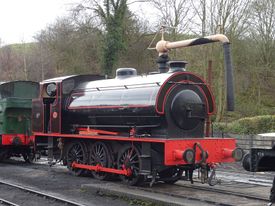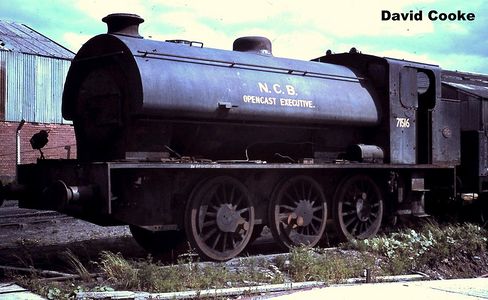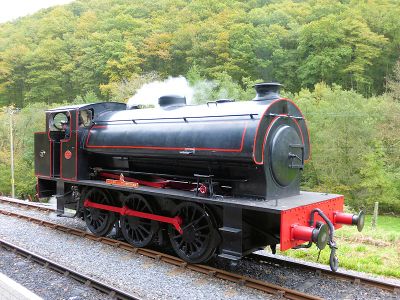WD 71516 Welsh Guardsman
| WD 71516 Welsh Guardsman | |
|---|---|
 WD 71516 Welsh Guardsman at Bridgnorth | |
| Built By | Robert Stephenson & Hawthorns |
| Configuration | 0-6-0ST |
| Status | Stored |
| Loco Number | WD 71516 |
| Other Numbers | Works Number RSH 7170/1944 |
| History | |
| Built | 1944 |
| Designed By | Hunslet Engine Company |
| Type | WD Austerity |
| 1947 | Entered NCB service |
| 1980 | Preserved |
| 2013/14 | Overhauled and rededicated |
| 2020 | Arrived on SVR |
| Technical | |
| Length | 30ft 4" |
| Weight | 48t 5cwt |
| Tractive effort | 23.870 lb |
| Pressure | 170 lb/sq in |
WD 71516 "Welsh Guardsman" is a WD Austerity 0-6-0ST. It arrived on the SVR in February 2020, initially as a temporary resident. It hauled SVR trains from 2022.
At the beginning of World War 2 the War Department initially selected the LMS 3F 0-6-0T 'Jinty' as its standard shunting locomotive. However they were persuaded by the Hunslet Engine Company that a simplified version of that company's 50550 0-6-0ST design would be more suitable. The first locomotive was completed at their Leeds works at the start of 1943, with a total of 377 being ordered during the war and completed to the requirements of the Ministry of Supply by 1947. A number of these engines were built by Andrew Barclay, W. G. Bagnall, Hudswell Clarke, Robert Stephenson and Hawthorns, and the Vulcan Foundry, all acting as sub-contractors.
After the war ended, many of the military examples were sold into industry with only 90 being retained for use on military railways. 75 were also sold to the LNER who classified them as J94. At the same time construction of the type continued for use in industry, while a further small batch was also built for the War Department in the 1950s including former SVR resident WD 193 Shropshire. A total of 485 were eventually produced, with the last examples not completed until 1964.
Contents
WD 71516 in service
WD 71516 was built for the War Department by Robert Stephenson & Hawthorns in 1944 as Works Number 7170. It was delivered new to the Ministry of Fuel & Power and was based at East Cramlington in Northumberland.
After wartime service ended, the locomotive was bought by the National Coal Board in 1947. It worked at various locations in Northumberland including Hartley Main Colliery at Killingworth, West Moor Colliery at Ashington, East Cramlington, and opencast mines at Swalwell, Widdrington and Broomhill.
In January 1959 the locomotive was moved to Carmarthenshire in South Wales, working at Cynheidre Colliery in the Gwendraeth valley. The locomotive was photographed there circa 1967 by David Cooke; at the time it was out if service as no coupling rods were fitted.
In October 1968 a further move took place to Graig Merthyr Colliery near Pontardulais, northwest of Swansea. From 1976 until 1980 the locomotive was retained at Pontardulais as a source of spares, before being saved by the Welsh Industrial & Maritime Museum[1][2].
WD 71516 in preservation
The Welsh Industrial and Maritime Museum was located in Butetown, Cardiff and closed in 1998 with its exhibits redistributed.[3]
On arrival at Bronwydd Arms on the Gwili Railway, WD 71516 was rebuilt using parts from other locomotives including the boiler from Hunslet No. 3822 and the cab and tank of Bagnall No 2758. The locomotive was given its war department number 71516 and named "Welsh Guardsman" in a special ceremony at Bronwydd Arms.[1] The locomotive was last overhauled at Llangollen between 2011 and 2013,[4] after which it was rededicated at a ceremony at Bronwydd Arms on 9 June 2014.[1]
On 27 February 2020 WD 71516 arrived by road at Bridgnorth. The SVR announced that it had ...agreed to host Welsh Guardsman while the owner decides on the operating opportunities for the loco during the 2020 season. Bridgnorth Locomotive Works will undertake some examination and maintenance work and we will potentially have the chance to use the locomotive.[5] The 2020 coronavirus disease (COVID-19) pandemic meant the locomotive stayed at Bridgnorth with occasional steamings within station limits only for exam purposes until, on 7 December 2020, the SVR announced that the locomotive was on hire to the Embsay & Bolton Abbey Steam Railway.[6] A further loan period followed in 2021/22 before the locomotive returned, making its SVR formal debut at the 2022 Spring Steam Gala before hauling service trains.
In 2022 investigation of a steam blow at the front end revealed that the cylinder block casting had failed, with the block beyond repair.[7]
The locomotive is owned by Felinfoel Brewery[1].
See also
References
- ↑ 1.0 1.1 1.2 1.3 Gwili Railway (retrieved 28 February 2020)
- ↑ Preserved British Steam Locomotives website (Retrieved 19 November 2021)
- ↑ Welsh Industrial and Maritime Museum on Wikipedia (Retrieved 29 February 2020)
- ↑ UK Locos (retrieved 28 February 2020)
- ↑ 'Welsh Guardsman touches down', Branch Lines March 2020 (Retrieved 7 December 2020)
- ↑ 'Meet Our Locomotives', SVR Website (Retrieved 7 December 2020)
- ↑ Branch Lines, June 2022

